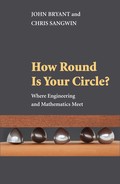Book Description
How do you draw a straight line? How do you determine if a circle is really round? These may sound like simple or even trivial mathematical problems, but to an engineer the answers can mean the difference between success and failure. How Round Is Your Circle? invites readers to explore many of the same fundamental questions that working engineers deal with every day--it's challenging, hands-on, and fun.
John Bryant and Chris Sangwin illustrate how physical models are created from abstract mathematical ones. Using elementary geometry and trigonometry, they guide readers through paper-and-pencil reconstructions of mathematical problems and show them how to construct actual physical models themselves--directions included. It's an effective and entertaining way to explain how applied mathematics and engineering work together to solve problems, everything from keeping a piston aligned in its cylinder to ensuring that automotive driveshafts rotate smoothly. Intriguingly, checking the roundness of a manufactured object is trickier than one might think. When does the width of a saw blade affect an engineer's calculations--or, for that matter, the width of a physical line? When does a measurement need to be exact and when will an approximation suffice? Bryant and Sangwin tackle questions like these and enliven their discussions with many fascinating highlights from engineering history. Generously illustrated, How Round Is Your Circle? reveals some of the hidden complexities in everyday things.
Table of Contents
- Cover
- Title
- Copyright
- Contents
- Preface
- Acknowledgements
- Chapter 1 Hard Lines
- Chapter 2 How to Draw a Straight Line
- Chapter 3 Four-Bar Variations
- Chapter 4 Building the World’s First Ruler
- Chapter 5 Dividing the Circle
- Chapter 6 Falling Apart
- Chapter 7 Follow My Leader
- Chapter 8 In Pursuit of Coat-Hangers
- Chapter 9 All Approximations Are Rational
- Chapter 10 How Round Is Your Circle?
- 10.1 Families of Shapes of Constant Width
- 10.2 Other Shapes of Constant Width
- 10.3 Three-Dimensional Shapes of Constant Width
- 10.4 Applications
- 10.5 Making Shapes of Constant Width
- 10.6 Roundness
- 10.7 The British Standard Summit Tests of BS3730
- 10.8 Three-Point Tests
- 10.9 Shapes via an Envelope of Lines
- 10.10 Rotors of Triangles with Rational Angles
- 10.11 Examples of Rotors of Triangles
- 10.12 Modern and Accurate Roundness Methods
- Chapter 11 Plenty of Slide Rule
- 11.1 The Logarithmic Slide Rule
- 11.2 The Invention of Slide Rules
- 11.3 Other Calculations and Scales
- 11.4 Circular and Cylindrical Slide Rules
- 11.5 Slide Rules for Special Purposes
- 11.6 The Magnameta Oil Tonnage Calculator
- 11.7 Non-Logarithmic Slide Rules
- 11.8 Nomograms
- 11.9 Oughtred and Delamain’s Views on Education
- Chapter 12 All a Matter of Balance
- Chapter 13 Finding Some Equilibrium
- Epilogue
- References
- Index
